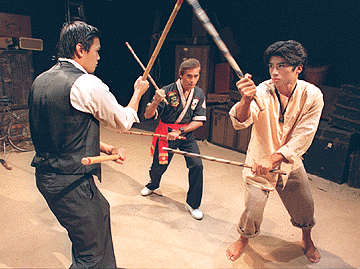
Maestro Mike Del Mar, center, instructs actors
Martin Romualdez and Mark Allen Malalis.
By Dennis Oda, Star-Bulletin

Maestro Mike Del Mar, center, instructs actors
Martin Romualdez and Mark Allen Malalis.
By Dennis Oda, Star-Bulletin
Filipino martial arts traditions predate the arrival of the Spanish in 1521 and were banned after the Spanish conquest. Kali-Escrima, incorporating the use of empty hands, blades and wooden weapons, was preserved in secret and passed down from one generation to the next.
"You'll see different styles because everything was shared (only) between family members or people with very close ties in a village or a province and not with anyone else," the soft-spoken Vietnam veteran explains. Filipino field workers brought kali-escrima to Hawaii and the mainland, but it remained within the ethnic Filipino community until the mainstream interest in all Asian martial arts led to it being "discovered" a little more than 20 years ago. It is now a tournament sport in California.
Del Mar founded the Del Mar School of Filipino Martial Arts - Kali-Escrima to perpetuate and share the traditions here. He has been sharing his knowledge with an unusual corps of students as the fight scene choreographer in Kumu Kahua's production of "PeregriNasyon."
"I wanted to present a melding of indigenous culture, the Spanish influences and American influences - the moves of kali-escrima become one of the core elements," explains playwright and director Chris B. Millado.
"PeregriNasyon" ("Wanderings") follows the experiences of two brothers whose separate choices take them on different paths. The men's experiences contrast the experiences of Filipinos in the Philippines during the U.S. occupation and those who emigrated to Hawaii and the mainland in the 1930s.
One of the major threads to the story is the revolt of the landless peasants in the Philippines who were trying to assert their right to own land. The other is the events that lead up to race riots in Watsonville, Calif.
"A lot of the fighting is used as movement vocabulary in the Philippine scenes, but traces of it are seen in the riot scenes too as a shared spiritual link," Millado adds. The staging juxtaposes the kaleidoscopic spectrum of revolutionary movements in the Philippines with the racial discrimination experienced by Filipinos in Hawaii and California.
"The stick fighting is used not only in scenes portraying combat but also to recreate the rituals of the secret organizations met.
'We've also brought in the southern Filipino empty-hand fighting style of silat, and the ritual chanting done during Lent to commemorate the life and suffering of Jesus Christ. Recent researchers have found that these were analogies of people suffering and preparing themselves for revolution and eventual resurrection," Millado says.